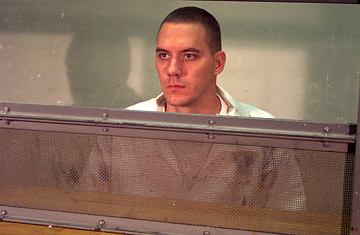
Jason Burkett during his interview in Werner Herzogs Into the Abyss
Nine years ago, two young men from Conroe, Texas, wanted a joyride in a red Camaro; and because they shot and killed three people while stealing it, Jason Burkett got life in prison, and Michael Perry got death. By Jul. 1, 2010, when the state of Texas killed Perry by lethal injection, a tree that had taken root under the impounded Camaro grew up through the floorboards, its branches curled around the seats. Police had to move the car to another lot; it was still an item of evidence when a detective showed it to Werner Herzog.
The subjects of Herzog's documentaries are typically visionaries seeking to triumph over impossible odds, from The Flying Doctors of East Africa in 1969 to the recklessly bear-loving Grizzly Man in 2005. In his last film, Cave of Forgotten Dreams, the mad-genius German director found kinship in the anonymous artists who drew their dreams 30,000 years ago in France's Chauvet caves. Into the Abyss, Herzog's Death Row doc that played at the Telluride and Toronto festivals, has no heroes, only villains and victims: the killers and their families, and the families of those they killed. Virtually everybody on screen in this modern In Cold Blood has been cursed by tragedy. They might be the survivors, or the carriers, of a devastating local plague.
The immediate casualties of this 2002 crime were Sandra Stotler, a nurse who lived in the gated community of Highland Ranch, her son Adam and Adam's friend Jeremy Richardson. But the circle of death spreads far beyond them. Over a six-year period Sandra's daughter Lisa Stotler-Balloun lost not only her mother and brother but everyone else in her family, from natural or violent causes. After this grievous Old Testament trial, Lisa disconnected her phone, telling Herzog, "I figure if I don't get close to anybody, I won't get hurt again." Jeremy's older brother Charles sports two teardrop tattoos: one for his murdered brother, the other for his sister, killed in a highway accident. Their father is in prison for murder, and Charles also has a rap sheet: "Everybody said that I was the one that was supposed to be dead before I was 21, and not Jeremy."
While the movie shows sympathy for the victims, it evokes some pity for the devils. As an infant, Jason Burkett contracted neuroblastoma, which required 18 surgeries before he was five; he was not expected to outlive his childhood. His father Delbert, who as a teen won a football scholarship to the University of Texas, dropped out of school and became a thief to support his drug and alcohol addiction; he has spent 40 years locked up on eight separate felony counts. Jason's brother Chris is also in jail. The three were allowed to have Thanksgiving dinner together, behind bars.
Thousands of such hapless criminals found their final rest in a state cemetery, where the unclaimed bodies lie in graves with no names, only numbers. Nearby stands a death-house chaplain, Richard Lopez, tears coursing down his face. "I cannot stop the process," he says. "I wish I could." He means the process of capital punishment — the state of Texas has killed more than 450 men (and six women) since it resumed the death penalty in 1982, whereas California, whose population is 50% larger, has executed 13. But the chaplain might also be referring to the social process of breeding criminals with low intellectual horizons and scant chance of escaping their sordid, sorry fates.
